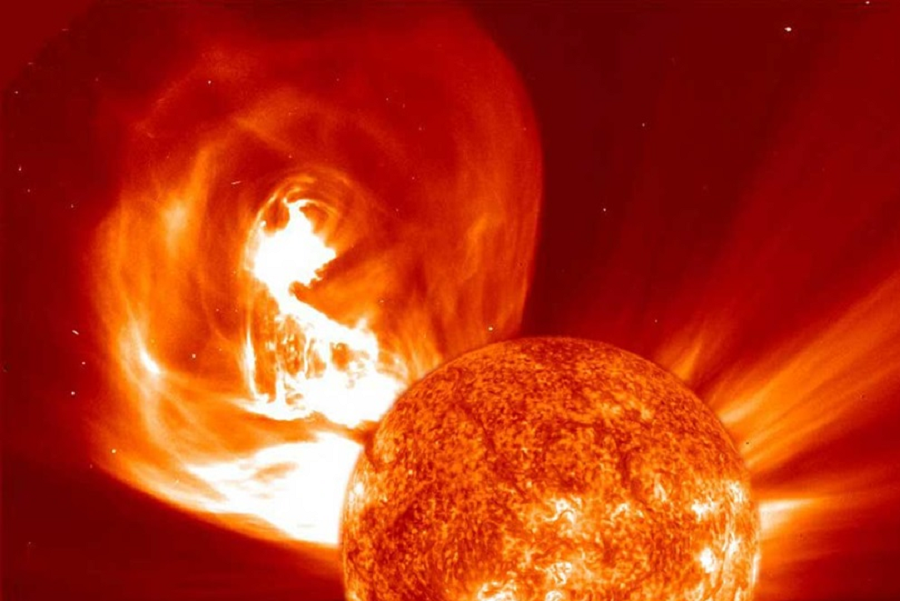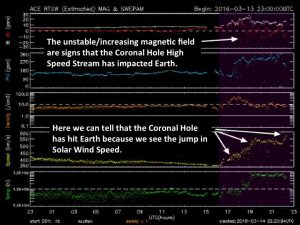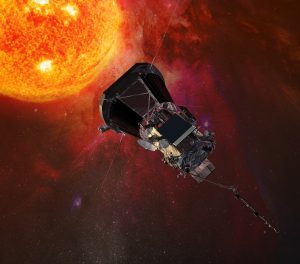
/ ESA / NASA
A coronal mass ejection (CME) launched from the sun may trigger a geomagnetic storm on Earth late on July 23 / early July 24. The National Weather Service Space Weather Prediction Center believes a G1 class geomagnetic storm is possible after a CME was hurled into space near Sunspot AR2846 on Tuesday. While much of the energy associated with the CME appears to be pointed away from Earth, scientists tracking the solar event believe that some energy may still reach Earth.
Geomagnetic storms are rated on a 1-5 scale, with 1 being the weakest and 5 having the most potential for damage. With this G1 geomagnetic storm threat, there could be weak power grid fluctuations and minor impacts on satellite operations are possible. Aurora, also known as the “Northern Lights”, could be visible at high latitudes from northern Michigan and Maine to points north.

Dark regions on the Sun known as coronal holes are one of the main drivers of space weather now. According to the Space Weather Prediction Center, coronal holes appear as dark regions on the Sun because they are cooler than the surrounding plasma and are open magnetic field lines. The Sun’s outermost part of its atmosphere, which is known as the corona, is where these dark regions appear. The solar corona was also one of the main features of the Sun scientists were most excited to study during the past solar eclipse. You are able to notice these features in extreme ultraviolet (EUV) and soft x-ray solar images.
Solar wind is always flowing from the Sun and towards Earth but coronal holes are known for releasing enhanced solar wind. Coronal holes can develop anywhere on the sun and are more common during solar minimum. One solar rotation of the Sun occurs every 27 days and coronal holes are sometimes able to last several of these. It is common to see persistent coronal holes at the north and south pole of the Sun but sometimes they can expand towards the equator of the Sun resulting in a larger region. Normally, coronal holes located near the Sun’s equator, result in faster solar wind arriving at Earth. It is common to see coronal holes produce G1-G2 geomagnetic storming levels and sometimes on rare occasions, upwards to G3 levels have been met.

NOAA forecasters analyze these features and have to take them into account during each forecast. If Earth is experiencing the effects of a coronal hole and a coronal mass ejection is forecasted to impact Earth, the combined effects could result in a more significant impact and more intense geomagnetic storming. Analyzing data from the DSCOVER and ACE satellite is one way forecasters can tell when the enhanced solar wind from a coronal hole is about to arrive at Earth. A few things they look for in the data to determine when the enhanced solar wind is arriving at Earth:
• Solar wind speed increases
• Temperature increases
• Particle density decreases
• Interplanetary magnetic field (IMF) strength increases
If you are an aurora chaser or space weather enthusiasts, you’ll want to become familiar with coronal holes. They will be providing much of our geomagnetic activity going forward and will remain persistent during solar minimum. Citizen Scientists should explore Aurorasaurus which allows you to share or get alerts and images on aurora activity with a community of others interested in space weather.
While these solar events can help illuminate the sky with stunning aurora, they can also do considerable harm to electronics, electrical grids, and satellite and radio communications.
On September 1-2 in 1859, a powerful geomagnetic storm struck Earth during Solar Cycle 10. A CME hit the Earth and induced the largest geomagnetic storm on record. The storm was so intense it created extremely bright, vivid aurora throughout the planet: people in California thought the sun rose early, people in the northeastern U.S. could read a newspaper at night from the aurora’s bright light, and people as far south as Hawaii and south-central Mexico could see the aurora in the sky.
The event severely damaged the limited electrical and communication lines that existed at that time; telegraph systems around the world failed, with some telegraph operators reporting they received electric shocks.

A June 2013 study by Lloyd’s of London and Atmospheric and Environmental Research (AER) in the U.S. showed that if the Carrington event happened in modern times, damages in the U.S. could exceed $2.6 trillion, roughly 15% of the nation’s annual GDP.
While typically known for their weather forecasts, the National Oceanic and Atmospheric Administration (NOAA) and its National Weather Service (NWS) is also responsible for “space weather.” While there are private companies and other agencies that monitor and forecast space weather, the official source for alerts and warnings of the space environment is the Space Weather Prediction Center (SWPC). The SWPC is located in Boulder, Colorado and is a service center of the NWS, which is part of NOAA. The Space Weather Prediction Center is also one of nine National Centers for Environmental Prediction (NCEP) as they monitor current space weather activity 24/7, 365 days a year.
Pretty much how it’s going. #CoronalHole #GeomagneticStorm #G1 pic.twitter.com/07XnTaK46f
— the Weatherboy (@theWeatherboy) April 30, 2021